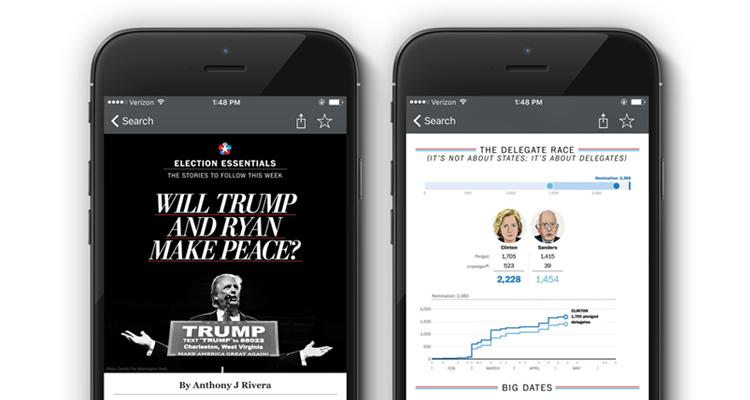While covering February’s Iowa Caucuses on Apple News, The Washington Post focused on explanatory journalism, telling users what the returns meant and what was coming up next.
Given the number of primaries and candidates early on, this turned into a weekly feature, said David Merrell, The Post’s senior mobile product manager.
On Monday, the Post announced plans to turn its election coverage on Apple News into a standalone briefing, “Election Essentials.” The weekly update comes out each Monday. Merrell and Chris Meighan, director of emerging news products, talked to Poynter via email about the new offering, how the Post is approaching content distributed on various platforms and what other newsrooms can learn from its efforts.
Why did The Washington Post opt to create content exclusively for Apple News?
Merrell: We go where the readers are, and Apple News is installed on every iPhone, iPad and iPod touch in the U.S., U.K. and Australia. That is a huge audience of people who may not be familiar with The Washington Post, so creating new content for those readers as a doorway into the rest of our coverage was a no-brainer.
The Emerging News Products Team is behind this project. Can you tell us more about that team?
Meighan: The Emerging News Products Team is a 20-person group made up of editors, designers and producers. Over the past two years, the team has launched The Post’s national product suite, which includes tablet and smartphone apps, a newsletter and an Apple Watch presence. The team has also worked on many of The Post’s distributive platform initiatives, including Apple News and other news platforms.
The team operates on an editorial philosophy and design sensibility that takes advantage of the small screen for mobile-first storytelling. The Emerging News Products Team is consistently in the innovations mindset, knowing that once something is launched, it’s on to figuring out what the next big thing will be for the best reader experience.
What results have you seen so far?
Merrell: We have been very pleased with the increase in engagement we’ve seen so far from having Election Essentials featured in Apple News every week.
This is a weekly briefing about the election. Why was politics coverage a good fit?
Meighan: For us, politics was an obvious choice. We feel that The Washington Post has the most comprehensive election coverage out there. Our journalists cover every possible angle, so we are confident that we are providing the Apple News audience with a well-rounded report to start each week.
What’s the Post’s strategy for distributed content? How does this fit?
Merrell: We believe strongly in going where the readers are. The Post’s strategy for distributed content is simple: we partner with new platforms as early as possible to see if there is a strategic fit, experiment when it makes sense, and learn what is resonating with users.
How can other publishers replicate your strategy with Apple News (or can they)?
Merrell: Publishers often view distributed content as an engineering problem (“How do we get our content into this format?”) and a business problem (“Should we even be sending articles?”), but rarely as an editorial problem (“What do the platform’s users want to read?”). Once a publisher is on a distributed platform, it’s safe to assume they have answered the first two questions.
Now it’s time to consider the third question — and anyone can do that by comparing their site and app analytics to what they are seeing on the distributed platform, looking for opportunities both within your set of content and the platform as a whole, and then seizing them.







